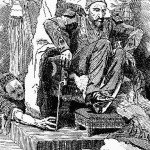
The Ottoman Empire before World War I was in a state of rapid transition and decay. Through the medieval period and into the modern era, the Ottoman Empire had been one of the world’s largest imperial powers. In the 17th century the Muslim Ottomans ruled vast swathes of eastern Europe, northern Africa and the Middle East. Ottoman power extended from the Persian Gulf to central Europe; Ottoman sultans ruled almost the entire north coast of Africa and west to Egypt and the Holy Lands (modern-day Israel and Palestine). The Ottoman navy ruled the waters of the Mediterranean, while their traders rivaled those of Spain, Portugal and the Italian city-states. The empire was governed from Constantinople (modern-day Istanbul, Turkey); its ruler was the sultan, the heir to a powerful royal family. In 1683 the Ottomans invaded Austria with an army of 200,000 men and laid siege to Vienna, a city they had long coveted. It took a massive combined force of Austrians, Germans and Poles to defend the Austrian capital and drive the Ottomans from central Europe.
This defeat, along with the inept leadership of several weak sultans, saw Ottoman expansion stall during the 1700s. The 19th century was one of degradation, as the Ottomans struggled to retain control of their empire, in the face of external pressure and internal turmoil. By the 1850s the situation was so desperate that Tsar Nicholas I of Russia famously described the Ottoman Empire as “the sick man of Europe”. He was soon proved correct, while the sickness later became terminal. There were several reasons for this decline. As in other large empires of the time, the Ottomans were confronted with rising nationalism and opposition, as ethnic and regional groups demanded self-determination and independence. The once-formidable military power of the Ottoman Empire also decreased significantly. The Ottomans were driven out of north Africa and Egypt after a series of unsuccessful wars.
Recognising their weakening military position and incapacity to wage war, Ottoman leaders began seeking alliances with European nations. Internally the Ottoman Empire was also suffering from a failing economy. Centuries before the Ottomans ruled the world’s richest empire, but by the 1800s they had long been overtaken by the trading strength of the British, French and other European powers. By the 1870s the Ottomans owed more than 200 million pounds to European banks; the annual repayments on their loans and interest comprised more than half the national revenue.
“The periodic crises of the Eastern Question – the fragmentation of the Ottoman Empire with its implied threat to European peace – had produced rivalry and tension in the political relations among the Powers… The Ottoman Empire was vulnerable to many pressures. Spread over a vast area… it contained many subject peoples and many diverse regions. Fighting a rear-guard battle with nationalist independence movements within its borders, and European imperial ambitions from without them, the Empire had one trump card: the general desire of the European Powers for it to survive as a political entity, for its total disintegration was a worse alternative.”
Marian Kent, historian
By the mid-1800s the empire’s internal problems, as well as the infiltration of Western ideas, led to calls for modernisation. The Edict of Tanzimat (1839) introduced sweeping European-inspired reforms to Ottoman military organisation, farming, public administration, even uniforms and dress. In 1876 a group of young Ottomans, who had been educated in European universities, launched a short-lived revolution: they overthrew the sultan, drafted a liberal constitution and backed a moderate leader to rule as a constitutional monarch. These political reforms did not last, however they were revived in 1908 by the Young Turk movement, which restored the constitution and the Ottoman Parliament. One of the Young Turks, Mustafa Kemal, was a young army officer who played a minor role in the 1908 revolution. Kemal would later make history by commanding Turkish forces at Gallipoli (1915) and leading his nation to independence from Allied occupation (1923).

By 1908 the Ottoman Empire was crumbling, a situation which troubled the rulers and diplomats of Europe. The Ottomans occupied an area of geographic and strategic importance, including extensive Mediterranean and Black Sea coastline and the Bosphorus, a strait of water connecting the Black Sea to the Mediterranean. Russia and Austria-Hungary saw the break-up of the Ottoman lands as an opportunity to increase their own territory and influence. Control of the Bosphorus would also give Russia’s strong Black Sea navy access to the Mediterranean. Conversely, Britain and Germany hoped the Ottomans could hold their empire together and continue serving as a buffer against the territorial ambitions of Austria-Hungary and Russia. To serve these agendas, European leaders – particularly those of Britain, France and Germany – all sought some form of Ottoman alliance in the early 1900s.
This placed Ottoman politicians in the precarious position of having to choose foreign allies – or to proceed with none at all. There was little support in the sultan’s ranks for an alliance with France, since its closest ally was Russia, a bitter enemy of the Ottomans. A moderate faction favoured an agreement with Britain, which controlled nearby Egypt and southern Iraq and could offer trade deals. Others among the Ottomans preferred neutrality, believing the empire should remain disconnected from European intrigues and tensions. It was Germany’s strong position against Russia, along with promises of financial support and the construction of a Berlin-to-Baghdad railway, that ultimately won the day.

1. The Ottoman Empire was once a superpower, ruling the Middle East and much of northern Africa and eastern Europe.
2. By the end of the 1800s the empire was in decline, shrinking in size and subject to internal problems and instability.
3. There were attempts at political reform, such as the Young Turk rebellion, though they did not arrest the decline.
4. Despite its 19th century problems, the Ottomans occupied a critical position, controlling access to the Black Sea.
5. The European powers showed a strong interest in the future of the empire, particularly Germany, which invested in the Berlin-Baghdad railway that passed through Ottoman territory.
© Alpha History 2014. Content on this page may not be republished or distributed without permission. For more information please refer to our Terms of Use.
This page was written by Jennifer Llewellyn, Jim Southey and Steve Thompson. To reference this page, use the following citation:
J. Llewellyn et al, “Ottoman Empire before World War I” at Alpha History, https://alphahistory.com/worldwar1/ottoman-empire/, 2014, accessed [date of last access].
